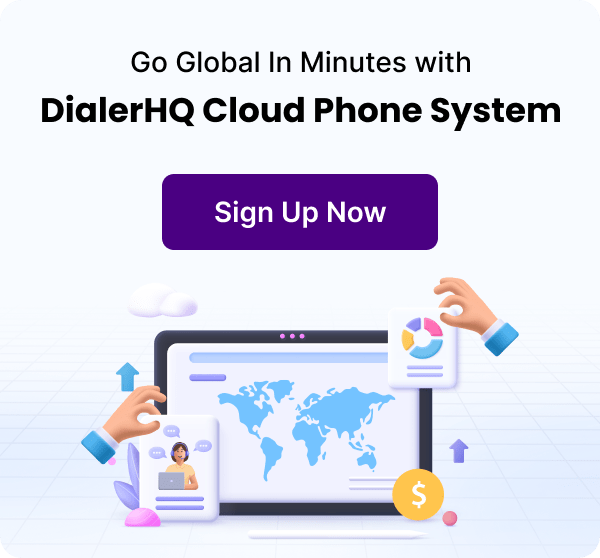Senior Writer: Paras Kela
Efficiency and effectiveness are crucial in customer service. One aspect often overlooked is “Wrap-Up Time.” This term refers to the time a customer service representative spends completing tasks after a customer interaction, such as documenting notes, updating records, or preparing for the next interaction. Streamlining this process can help your team handle more calls and improve productivity.
In this blog post, we will look into what wrap-up time entails and why it holds immense importance in the realm of customer service.
What is Wrap-Up Time?
Wrap-up time, also known as after-call work, is the period during which a customer service agent finalizes their work related to a customer interaction.
This could involve updating customer records, logging details of the conversation, or even preparing for the next customer inquiry. Essentially, it’s the time spent wrapping up loose ends associated with a specific customer interaction.
There are various components of wrap-up time. Let’s have a detailed look at them:
Prioritize efficient documentation and use automation tools to streamline after-call work for optimal wrap-up time. Additionally, encourage continuous training for agents to enhance proficiency in handling post-interaction tasks, ensuring a seamless and responsive customer service experience. Invest in advanced cloud phone systems such as DialerHQ to ensure a seamless communication experience and increase key bottom-line results.
1. Documentation
One crucial aspect of wrap-up time is documenting the details of the interaction. Agents need to accurately record the customer’s concerns, resolutions offered, and any follow-up actions required. This documentation serves as a valuable resource for future interactions and helps maintain a comprehensive customer history.
2. System Updates
Agents often need to update various systems and databases with the latest information gathered during customer interaction. This ensures that all relevant departments within an organization have access to the most up-to-date customer data.
3. Preparation for the Next Interaction
Efficient use of wrap-up time involves preparing for the next customer inquiry. Agents may need to review relevant materials, gather additional information, or engage in any other activities that ensure a seamless transition to the next interaction.
How to Calculate Wrap Time?
Wrap-up time is a critical metric in customer service operations, representing the period during which call center agents complete necessary tasks after a customer interaction. Calculating wrap time accurately is essential for understanding operational efficiency, identifying areas for improvement, and optimizing overall customer service performance –
Here’s a simplified explanation:

Wrap-up time = Total Time Spent on Wrap-Up Activities/Number of Interactions or Agents?
Total Time Spent on Wrap-Up Activities
This encompasses the cumulative time spent by all agents on after-call work, including tasks like documenting interactions, updating records, and preparing for the next inquiry.
Number of Interactions or Agents
Depending on the focus of your analysis, this represents either the total number of customer interactions during a specific period or the number of agents involved in providing customer service.
Example:
Suppose you want to calculate the average call wrap-up time for a team of customer service agents over the course of a day.
- Total Time Spent on Wrap-Up Activities = 450 minutes
- Number of Agents = 10
Wrap up time = 450 minutes/10 agents
= 45 Minutes per agent.
This result indicates that, on average, each agent spends 45 minutes on wrap-up activities after handling customer interactions.
How to Reduce Average Wrap-Up Time?
Wrap-up time, the critical period after a customer interaction is a key determinant of overall customer service efficiency. Reducing average wrap-up time not only enhances responsiveness but also contributes to improved agent productivity and customer satisfaction. Below are the main ways to reduce call wrap-up time –

1. Implement Efficient Workflow Processes
Streamline workflow processes to minimize redundant steps and ensure a logical sequence of tasks during wrap-up. Identify and eliminate bottlenecks that may contribute to delays, allowing agents to navigate through post-interaction activities seamlessly.
2. Provide Comprehensive Training
Invest in training programs that equip agents with the skills to efficiently handle wrap-up tasks. Ensure they are proficient in using customer service tools, databases, and documentation processes. Well-trained agents are more likely to complete wrap-up activities swiftly and accurately.
3. Utilize Automation for Routine Tasks

Integrate automation for routine and repetitive wrap-up tasks. Automation can significantly reduce the manual effort required for data entry, record updates, and other administrative functions. This not only accelerates the wrap-up process but also minimizes the risk of errors.
4. Optimize Technology and Software
Regularly assess and update customer service software and tools. Ensure that these systems are user-friendly, efficient, and capable of supporting quick access to customer information. Up-to-date technology contributes to a smoother wrap-up experience.
Why is Wrap-Up Time Important?
Amid the buzz of resolving issues and addressing queries, one often-underestimated aspect plays a pivotal role in shaping the overall customer experience – Wrap-Up Time. Let’s delve deeper into the reasons why wrap-up time is of paramount importance in the realm of customer service.

1. Precision in Documentation
Precise documentation provides a structured space for agents to record details of the conversation, including customer concerns, preferences, and resolutions offered. This documentation serves as a treasure trove of information for future interactions, enabling agents to deliver a more personalized and effective service.
2. Comprehensive System Updates
In a tech-driven customer service landscape, staying abreast of the latest customer information is crucial. Wrap-up time allows agents to update various systems and databases promptly. This ensures that every department within an organization has access to real-time customer data, facilitating a seamless and coherent customer service experience.
3. Strategic Preparation for the Next Interaction
Efficient use of wrap-up time extends beyond routine tasks; it involves strategic preparation for the next customer interaction. Agents can review customer history, gather additional information, and equip themselves with the necessary tools to address future inquiries promptly. This proactive approach contributes to a smoother customer service workflow.
4. Enhanced Service Quality

The value of comprehensive wrap-up time becomes evident in the enhancement of service quality. Thorough documentation and systematic updates empower agents to understand customer needs holistically. This knowledge, accumulated over multiple interactions, allows agents to provide more informed and tailored solutions, thereby elevating the overall quality of service.
5. Optimized Efficiency in Workflow
A well-utilized wrap-up time is a catalyst for workflow efficiency. Agents can swiftly retrieve and update customer information, minimizing redundancy in subsequent interactions. This optimized workflow is instrumental, especially in high-volume customer service scenarios, ensuring that agents can handle a greater number of queries without compromising on quality.
6. Facilitation of Knowledge Transfer
The insights gathered during wrap-up time are not confined to individual agents; they contribute to the collective knowledge pool of the entire customer service team. This knowledge transfer is invaluable for maintaining consistency across interactions, ensuring that every team member is well-informed about the nuances of customer interactions.
7. In-Depth Performance Analysis
Call center wrap-up time metrics serve as a powerful tool for performance analysis. By monitoring the time spent on after-call work, organizations can gauge the efficiency of their agents, identify areas for improvement, and implement targeted training programs. This data-driven approach contributes to the ongoing refinement and enhancement of customer service capabilities.
You May Also Read : Call Center Analytics: A Complete Guide
Factors That Affect Wrap-Up Time
Wrap-up time, the often-overlooked interval following a customer interaction, is not immune to the influence of various factors. Below, we have listed the main factors that impact wrap-up time –

1. Complexity of Customer Queries
The nature and complexity of customer inquiries play a pivotal role in determining wrap-up time. Complex issues may require more extensive documentation and system updates, elongating the after-call work period. Understanding the correlation between query complexity and wrap-up time is crucial for managing resources effectively.
2. Information Accessibility
The availability and accessibility of information significantly impact wrap-up time. If agents can swiftly retrieve customer data and update systems seamlessly, the wrap-up process becomes more efficient. Conversely, challenges in accessing information can prolong after-call work, affecting overall service responsiveness.
3. Technological Infrastructure
The state of an organization’s technological infrastructure directly influences wrap-up time. An efficient and integrated system facilitates quick updates and documentation, reducing the time agents spend on post-interaction tasks. Outdated or fragmented technologies may impede the wrap-up process, leading to delays.
4. Agent Experience and Training

The proficiency of customer service agents plays a crucial role in determining how effectively wrap-up time is utilized. Well-trained agents with a deep understanding of systems and processes can navigate post-interaction tasks more efficiently. Investing in continuous training ensures that agents maximize their productivity during wrap-up time.
5. Workflow Optimization
The overall workflow design within a customer service operation impacts wrap-up time. An optimized workflow streamlines the post-interaction process, allowing agents to transition seamlessly from one customer inquiry to the next. Any bottlenecks or inefficiencies in the workflow can lead to delays in wrap-up time.
6. Volume of Customer Interactions
The sheer volume of customer interactions is a critical factor influencing wrap-up time. In scenarios where agents handle a high number of queries, efficient wrap-up becomes paramount. Organizations must balance workload and allocate resources effectively to ensure that wrap-up time does not become a bottleneck in delivering timely and quality service.
7. Integration of Automation
Automation plays a transformative role in minimizing wrap-up time. Integrating automated processes for routine tasks, such as data entry or record updates, can significantly reduce the manual effort required during wrap-up. Strategic implementation of automation aligns with a more streamlined and time-efficient after-call work process.
Conclusion
By implementing the strategies outlined in this exploration, organizations can navigate this terrain with confidence, ensuring that every post-interaction moment is an opportunity to elevate the customer service experience. As businesses continue to evolve in response to ever-changing landscapes, the optimization of wrap-up time remains a key determinant of success, paving the way for enduring customer loyalty and organizational growth.
Frequently Asked Questions
The industry standard for wrap-up time in customer service can vary, but it typically falls within the range of 15 seconds to 2 minutes. Organizations may establish their benchmarks based on the complexity of interactions and specific business needs.
Wrapping up a call involves completing essential tasks after a customer interaction. This includes documenting details of the conversation, updating records, and preparing for the next inquiry. Agents aim to efficiently conclude these tasks to ensure a smooth transition to subsequent interactions.
Wrap time for agents refers to the duration spent on after-call work following a customer interaction. It includes activities such as documentation, system updates, and preparation for the next inquiry. The goal is to manage this time effectively to balance efficiency and service quality.

Paras Kela is an accomplished IT professional with 7+ years of industry experience, including 4+ years as a dedicated content writer. His expertise lies in crafting informative blogs on VoIP and cloud telephony, among other technical subjects. Outside his professional pursuits, he cherishes quality time with loved ones, indulges in watching documentaries, and finds solace in gardening.
Updated : February 29, 2024

Subscribe to our newsletter & never miss our latest news and promotions.





